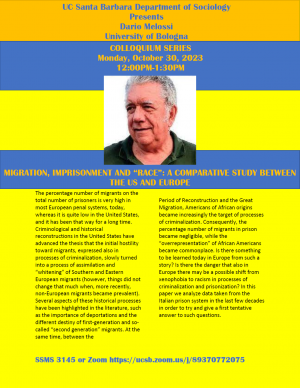Event Date:
Event Date Details:
This event is in-person and via Zoom https://ucsb.zoom.us/j/89370772075
Event Location:
- SSMS 3145
Dario Melossi, University of Bologna
Migration, Imprisonment, and “Race”: A Comparative Study Between the U.S. and Europe
The percentage number of migrants on the total number of prisoners is very high in most European penal systems, today, whereas it is quite low in the United States, and it has been that way for a long time. Criminological and historical reconstructions in the United States have advanced the thesis that the initial hostility toward migrants, expressed also in processes of criminalization, slowly turned into a process of assimilation and “whitening” of Southern and Eastern European migrants (however, things did not change that much when, more recently, non-European migrants became prevalent). Several aspects of these historical processes have been highlighted in the literature, such as the importance of deportations and the different destiny of first-generation and so-called “second generation” migrants. At the same time, between thePeriod of Reconstruction and the Great Migration, Americans of African origins became increasingly the target of processes of criminalization. Consequently, the percentage number of migrants in prison became negligible, while the “overrepresentation” of African Americans became commonplace. Is there something to be learned today in Europe from such a story? Is there the danger that also in Europe there may be a possible shift from xenophobia to racism in processes of criminalization and prisonization?In this paper we analyze data taken from the Italian prison system in the last few decades in order to try and give a first tentative answer to such questions.

